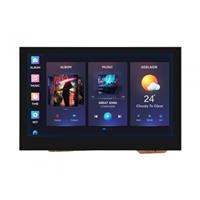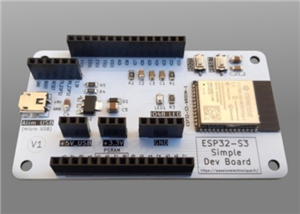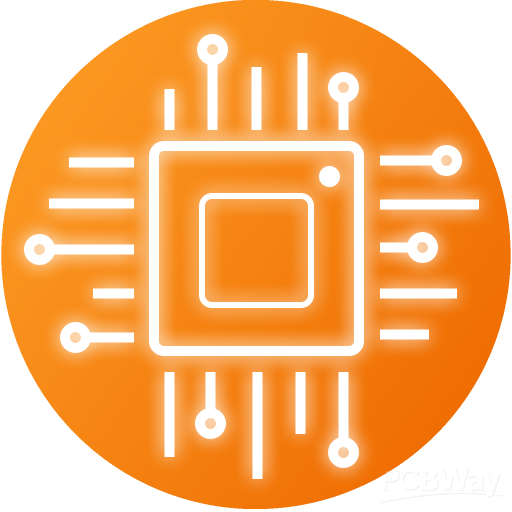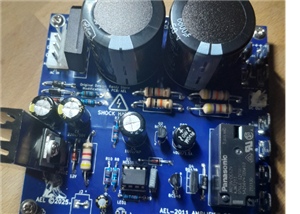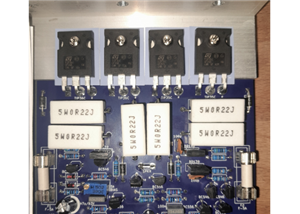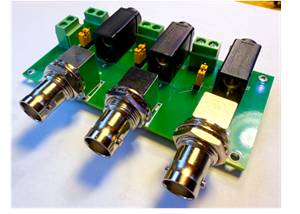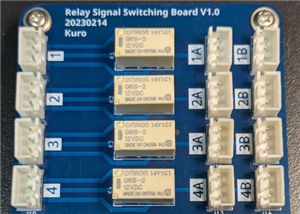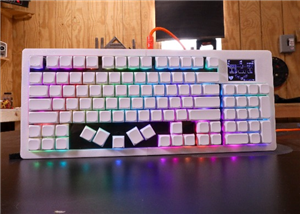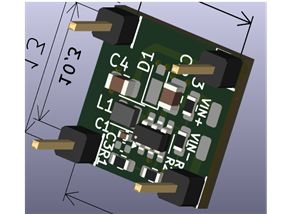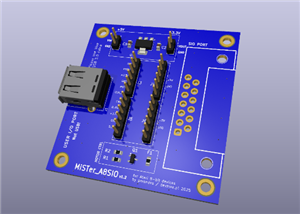|
|
DIY Ultrasonic Levitator KIT |
x 1 |

|
Soldering iron (generic) |
Ultra cheap Ultrasonic levitation Device - functionality and testing
Ultrasonic levitation is phenomenon where objects are suspended in mid-air using the power of sound waves. Specifically, it involves the use of high-frequency sound waves, typically beyond the range of human hearing (above 20 kHz), to create a standing wave pattern that can counteract the force of gravity and hold small objects in place.

In one of my previous videos , I described a way to make an ultrasonic levitation device, which, although seemingly simple to make, in practice required lengthy setup, used some unusual components, and required a lot of power. I recently came across an Ultrasonic Levitation kit that contains components, a PCB, and instructions with a schematic diagram, for the incredibly low price of a few dollars. I immediately purchased one and decided to build and test it.
First, let's see what the kit consists of.
- STC15F104W single chip microcontroller
- tps70933 Voltage regulator wich provide 3.3V for microcontroller
- TC4427 Dual High-Speed Power MOSFET Driver - Which directly drives the ultrasonic transducers
- Two ultrasonic transducers
- 3 PCBs
- Bumpers with screws
- Schematic diagram
- And a few passive SMD components, resistors and capacitors

This project is sponsored by Altium 365 . Altium 365 is a cloud-based platform designed for electronics design and engineering. It provides a suite of tools for PCB design tools, including Requipments management, Supply chain, Library managment, ECAD connectivity, Co-design and integration, and manufacturing portal.

It is immediately clear that these are very small SMD components, so soldering with a standard soldering iron will be a real challenge and exercise. I was really positively surprised by the use of a microcontroller in this inexpensive device, so I hope it will work well. Now I will approach soldering the components using a magnifying glass with high magnification, keeping in mind that well-soldered components are a basic requirement for the proper functioning of the device. I will skip this part so as not to overload the video and devote more time to testing.

After soldering the components, I visually inspected the PCB and checked for any errors or short circuits. Then I connected the device to a laboratory power supply for the first time with the current protection activated at 150mA. As you can see, the constant current protection is activated, and the TC4427 chip heats up, which is an almost certain sign that it is not working.

Fortunately, I had a UCC27524 IC from one of my previous projects for making a Tesla Coil. This chip has an identical pinout as the TC4427, only it is designed for much higher currents. So it can be put in its place without any modifications.
Let me explain the basic principle of operation of this device. When both transducers are activated, they emit ultrasonic waves toward each other. The waves interfere with each other, creating a standing wave pattern in the space between the transducers. In a standing wave, there are fixed points of maximum displacement (antinodes) and points of no displacement (nodes). The nodes are regions of low pressure, while the antinodes are regions of high pressure. Small lightweight objects placed in the standing wave experience an acoustic radiation force. This force pushes the objects toward the nodes (low-pressure regions) of the standing wave, where they become trapped, and they float.

To form standing waves, it is necessary to place the two transducers at a precisely defined distance, which roughly represents an integer multiple of half the wavelength. Specifically in our case, for a frequency of 40 kHz the half-wavelength is 4.29 mm, which means that the distance between the transducers can be n multiplied by 4.29 = 4.29mm, 8.58mm, 12.87mm, etc... This distance may vary slightly depending on atmospheric conditions.
Now, let's perform some basic tests and see if and how the device works in real conditions. First, with this small oscilloscope I want to look at the shape and frequency of the signal that is generated by the microcontroller and then amplified by the mosfet driver chip.

We measure this signal directly at the transducer. So we can see that a clean rectangular signal with a frequency of 40 kHz is generated. This is a good sign for normal operation of the device. Taking into account the previous calculations, the distance between the transducers is about 2.5 cm. Next, we need to carefully try to place a small Styrofoam ball in the space between the two transducers. In this part we need to be patient, because we will need more time to practice placing the particles. We may also need to experiment a little with the distance.

And finally, a brief conclusion. This is an incredibly cheap and visually fascinating toy through which we can learn a lot about the behavior and physics of standing waves, and also a great way to practice soldering SMD components.

Ultra cheap Ultrasonic levitation Device - functionality and testing
- Comments(0)
- Likes(0)
- 0 USER VOTES
- YOUR VOTE 0.00 0.00
- 1
- 2
- 3
- 4
- 5
- 6
- 7
- 8
- 9
- 10
- 1
- 2
- 3
- 4
- 5
- 6
- 7
- 8
- 9
- 10
- 1
- 2
- 3
- 4
- 5
- 6
- 7
- 8
- 9
- 10
- 1
- 2
- 3
- 4
- 5
- 6
- 7
- 8
- 9
- 10
 More by Mirko Pavleski
More by Mirko Pavleski
-
 Arduino 3D Printed self Balancing Cube
Self-balancing devices are electronic devices that use sensors and motors to keep themselves balanc...
Arduino 3D Printed self Balancing Cube
Self-balancing devices are electronic devices that use sensors and motors to keep themselves balanc...
-
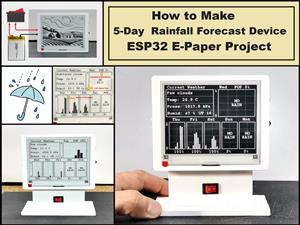 DIY 5-Day Rainfall Forecast Device - ESP32 E-Paper Project
In several of my previous projects I have presented ways to make weather stations, but this time I ...
DIY 5-Day Rainfall Forecast Device - ESP32 E-Paper Project
In several of my previous projects I have presented ways to make weather stations, but this time I ...
-
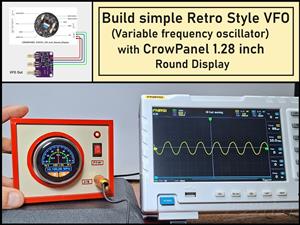 Build simple Retro Style VFO (Variable frequency oscillator) with Crowoanel 1.28 inch Round Display
Today I received a shipment with a Small round LCD display from Elecrow. The device is packed in tw...
Build simple Retro Style VFO (Variable frequency oscillator) with Crowoanel 1.28 inch Round Display
Today I received a shipment with a Small round LCD display from Elecrow. The device is packed in tw...
-
 Human vs Robot – Rock Paper Scissors with MyCobot 280 M5Stack
Today I received a package containing the few Elephant Robotics products. The shipment is well pack...
Human vs Robot – Rock Paper Scissors with MyCobot 280 M5Stack
Today I received a package containing the few Elephant Robotics products. The shipment is well pack...
-
 How to Build a Simple Audio Spectrum Analyzer with Adjustable Settings
An audio spectrum analyzer is an electronic device or software tool that measures and visually disp...
How to Build a Simple Audio Spectrum Analyzer with Adjustable Settings
An audio spectrum analyzer is an electronic device or software tool that measures and visually disp...
-
 How to Make a Digital Clock on a Vintage B&W TV using Arduino
These days I accidentally came across this small retro Black and White TV with a built-in Radio, so ...
How to Make a Digital Clock on a Vintage B&W TV using Arduino
These days I accidentally came across this small retro Black and White TV with a built-in Radio, so ...
-
 Build a $10 Function Generator with Frequency Meter for Your Lab
A function generator is a piece of electronic test equipment used to generate various types of elec...
Build a $10 Function Generator with Frequency Meter for Your Lab
A function generator is a piece of electronic test equipment used to generate various types of elec...
-
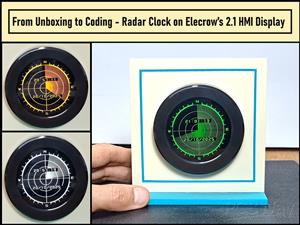 From Unboxing to Coding - Radar Clock on Elecrow’s 2.1 HMI Display
Today I received a shipment with a large round LCD display from Elecrow. The device is packed in two...
From Unboxing to Coding - Radar Clock on Elecrow’s 2.1 HMI Display
Today I received a shipment with a large round LCD display from Elecrow. The device is packed in two...
-
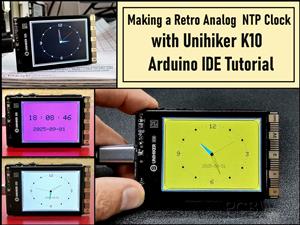 Making a Retro Analog NTP Clock with Unihiker K10 - Arduino IDE Tutorial
Some time ago I presented you a way to use standard Arduino libraries on the Unihiker k10 developme...
Making a Retro Analog NTP Clock with Unihiker K10 - Arduino IDE Tutorial
Some time ago I presented you a way to use standard Arduino libraries on the Unihiker k10 developme...
-
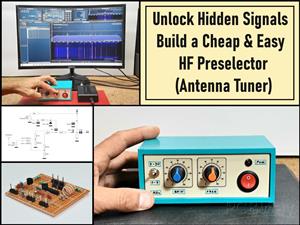 Build a Cheap & Easy HF Preselector - Antenna Tuner
HF antenna preselector is an electronic device connected between an HF radio antenna, and a radio r...
Build a Cheap & Easy HF Preselector - Antenna Tuner
HF antenna preselector is an electronic device connected between an HF radio antenna, and a radio r...
-
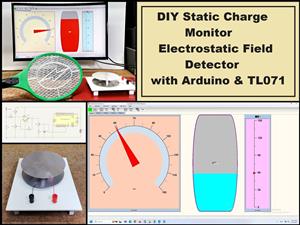 DIY Static Charge Monitor - Electrostatic Field Detector (Arduino & TL071)
A Static Charge Monitor also known as a Static Field Meter or Electrostatic Voltmeter is a device u...
DIY Static Charge Monitor - Electrostatic Field Detector (Arduino & TL071)
A Static Charge Monitor also known as a Static Field Meter or Electrostatic Voltmeter is a device u...
-
 XHDATA D-219 Radio Short Review with complete disassembly
Some time ago I received an offer from XHDATA to be one of the first test users of their new radio m...
XHDATA D-219 Radio Short Review with complete disassembly
Some time ago I received an offer from XHDATA to be one of the first test users of their new radio m...
-
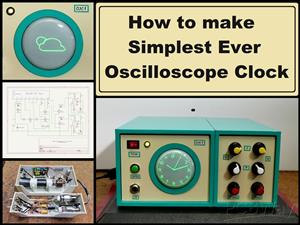 How to make Simplest ever Oscilloscope Clock
An oscilloscope clock is a unique and creative way to display the time using an oscilloscope, which...
How to make Simplest ever Oscilloscope Clock
An oscilloscope clock is a unique and creative way to display the time using an oscilloscope, which...
-
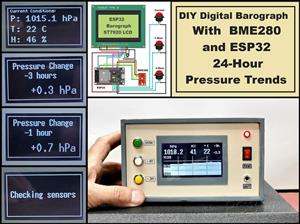 DIY Digital Barograph with BME280 and ESP32 - 24 Hour Pressure Trends
A barograph is a self-recording barometer that continuously measures and records atmospheric pressu...
DIY Digital Barograph with BME280 and ESP32 - 24 Hour Pressure Trends
A barograph is a self-recording barometer that continuously measures and records atmospheric pressu...
-
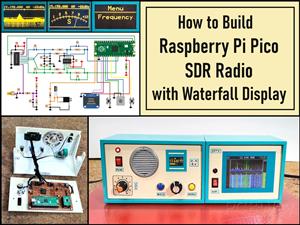 Build a Raspberry Pi Pico SDR Radio with Waterfall Display
Software-defined radio (SDR) is a radio communication system where components that have traditional...
Build a Raspberry Pi Pico SDR Radio with Waterfall Display
Software-defined radio (SDR) is a radio communication system where components that have traditional...
-
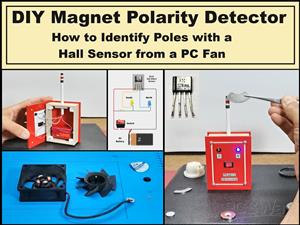 DIY Magnet Polarity Detector - How to Identify Poles with a Hall Sensor from a PC Fan
Recently, while working on a project, I needed to determine the polarity of several permanent magne...
DIY Magnet Polarity Detector - How to Identify Poles with a Hall Sensor from a PC Fan
Recently, while working on a project, I needed to determine the polarity of several permanent magne...
-
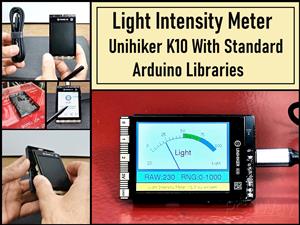 Light Meter Project - Making Dfrobot Unihiker K10 Work with Standard Arduino Libraries
The other day I received a shipment with a UNIHIKER K10 development board from DFRobot, which I rec...
Light Meter Project - Making Dfrobot Unihiker K10 Work with Standard Arduino Libraries
The other day I received a shipment with a UNIHIKER K10 development board from DFRobot, which I rec...
-
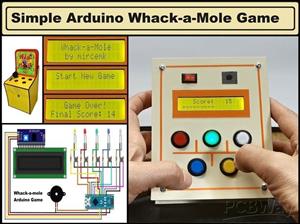 DIY Simple Arduino Whack-a-Mole Game
A "Whack-a-Mole" game is a classic arcade-style game where moles pop up randomly from holes, and th...
DIY Simple Arduino Whack-a-Mole Game
A "Whack-a-Mole" game is a classic arcade-style game where moles pop up randomly from holes, and th...
-
-
AEL-2011 Power Supply Module
524 0 2 -
AEL-2011 50W Power Amplifier
485 0 2 -
-
-
Custom Mechanical Keyboard
693 0 0 -
Tester for Touch Screen Digitizer without using microcontroller
329 2 2 -
Audio reactive glow LED wristband/bracelet with NFC / RFID-Tags
310 0 1 -
-
-


















